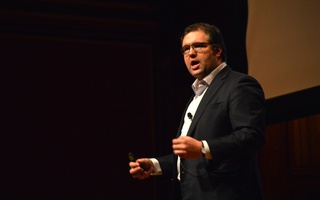Jeff Lichtman, a professor of molecular and cellular biology in the Neuroscience Department at Harvard, was recently lauded for his work with cutting-edge brain imaging techniques. The Crimson sat down with him to discuss his work.
The Harvard Crimson: In laymen’s terms, what is the focus of your recent work?
Jeff Lichtman: I’m interested in the relationship between the physical structure of the brain and its function. Unlike most other organ systems where this relationship is understood to a great degree, when it comes to the brain we still have very little information about how its physical structure explains its many complicated functions.
THC: How did you first get into this work?
JL: During my Ph.D., I studied a part of the nervous system that, in development, had a rather profound change in its wiring diagram. The nervous system is made up of nerve cells that are interconnected by these little wires called axons and dendrites. As animals are developing, the wiring diagram simplifies. Nerve cells are interconnected much more in babies than they are in adults. My Ph.D. work stimulated me to try to understand the rules that govern which connections stay and which go and to think about this as an example of how information about the world changes our nervous system, enabling us to adapt to living in new world environments.
THC: What about your work most excites you?
JL: Due to the brain’s extraordinary complexity, the challenge has always been to develop methodologies that would allow you to actually analyze the deep structure of the brain. There’s a tremendous technological conflict: we have techniques that can see high resolution and we have techniques that can see large areas, but rarely do the two coincide in the same technology. This is like doing a “Google map” of the brain at six-inch resolution, only for the entire earth. And, since the brain isn’t 2D, we’re mapping every layer from the surface to the middle. Every cubic millimeter of this kind of data is about a thousand terabytes.
THC: Where do you see this work moving in the future, in 10 or 20 years?
JL: One hopes eventually to apply these techniques to human brains, and use them to gain some insight into the physical underpinnings of mysterious phenomena like mental illness or learning disorders in children. There are probably connectopathies, diseases where the connections are pathological, but it’s very hard to study them until you have a means of doing so. In the long term it’s our hope that this approach will be amenable to looking at disease.
We also hope to eventually crack the mystery of how the brain stores information. Presumably it’s stored in a circuit, but what does the circuit look like when you drive or when you think of your grandmother?
Read more in News
The Family Van Makes Boston a Healthier CityRecommended Articles
-
‘Fortune Cookie’ Author Says ‘Yeah’ to the KongJennifer 8. Lee ’99 has spent the last seven years reporting for the New York Times Metro-City Room, traveling the
-
Q&A: John Lithgow Talks Arts First"It’s remarkable how many of the elements of that very first year are still in place 20 years later."
-
Lin: "This team has the potential to be the best ever."When the Harvard men’s basketball team (13-1) visited the Rice Owls (5-8) on Jan. 4, a familiar face—Jeremy Lin ‘10—watched from the stands.
-
 Harvard Thinks Big About Drugs, Brains, and Hip-Hop
Harvard Thinks Big About Drugs, Brains, and Hip-Hop













